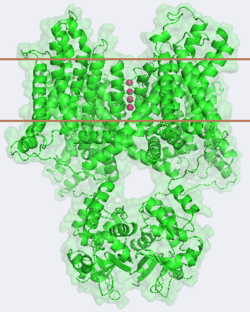Potassium channel Xavier
From Proteopedia
(Difference between revisions)
| Line 7: | Line 7: | ||
[[Image:2r9r Picture Proteopedia2.png|250px|left]] [[Potassium Channel]]'''s''' control cell membrane electric potentials by selectively allowing diffusion of K<sup>+</sup> across the membrane.<ref name="Zhou">PMID: 11689936</ref> K<sup>+</sup> | [[Image:2r9r Picture Proteopedia2.png|250px|left]] [[Potassium Channel]]'''s''' control cell membrane electric potentials by selectively allowing diffusion of K<sup>+</sup> across the membrane.<ref name="Zhou">PMID: 11689936</ref> K<sup>+</sup> | ||
| - | The structure is comprised of 4 identical subunits. | + | The structure is comprised of 4 identical subunits. Each subunit has a <scene name='Potassium_Channel/Voltage_sensors_opening/6'>voltage sensor</scene> and one fourth of the pore. |
There is the <scene name='Potassium_Channel/Trans/3'>transmembrane region</scene> marked between the parallel lines in the figure. This region houses | There is the <scene name='Potassium_Channel/Trans/3'>transmembrane region</scene> marked between the parallel lines in the figure. This region houses | ||
the <scene name='Potassium_Channel/Pore_opening/5'>channel pore</scene>, composed of interwoven helices in a teepee conformation, the all-important <scene name='Potassium_Channel/Selectivity_filter_opening/2'>“selectivity filter”</scene>, providing the channel with its remarkable 10,00 fold selectivity for K<sup>+</sup> ions over Na<sup>+</sup> ions and the <scene name='Potassium_Channel/Voltage_sensors_opening/4'>“voltage sensor”</scene> which is uses well placed arginine and acidic residues to determine the membrane polarity and open/close the channel in response.<ref name="Long"/> | the <scene name='Potassium_Channel/Pore_opening/5'>channel pore</scene>, composed of interwoven helices in a teepee conformation, the all-important <scene name='Potassium_Channel/Selectivity_filter_opening/2'>“selectivity filter”</scene>, providing the channel with its remarkable 10,00 fold selectivity for K<sup>+</sup> ions over Na<sup>+</sup> ions and the <scene name='Potassium_Channel/Voltage_sensors_opening/4'>“voltage sensor”</scene> which is uses well placed arginine and acidic residues to determine the membrane polarity and open/close the channel in response.<ref name="Long"/> | ||
| + | |||
| + | See what the The <scene name='Potassium_Channel/Open/1'>open channel</scene> looks like vs. The <scene name='Potassium_Channel/Closed/1'>closed channel</scene> ([[1k4c]]). Or view the morph of the <scene name='Potassium_Channel/Morph/3'>channel opening and closing</scene> (<scene name='Potassium_Channel/Morph/4'>Cartoon Design</scene>). | ||
====Overall mechanism==== | ====Overall mechanism==== | ||
| Line 15: | Line 17: | ||
The main steps that potassium ions go trough when leaving the cell are: | The main steps that potassium ions go trough when leaving the cell are: | ||
| - | * Voltage sensor | ||
* Entering the hydrophobic pocket | * Entering the hydrophobic pocket | ||
* Desolvation | * Desolvation | ||
* Selectivity filter | * Selectivity filter | ||
| + | * Explaining the voltage sensor and closing/opening of channel | ||
| + | |||
====Selectivity Filter and Pore==== | ====Selectivity Filter and Pore==== | ||
Revision as of 16:33, 13 September 2014
Important: This is a modified version of the original article on Potassium Channel. The purpose of this modification is simplifying the text and reversing the direction of potassium pumping.
Structure and mechanism of the potassium channel
Overview of structure
| |||||||||||
References
- ↑ 1.0 1.1 Zhou Y, Morais-Cabral JH, Kaufman A, MacKinnon R. Chemistry of ion coordination and hydration revealed by a K+ channel-Fab complex at 2.0 A resolution. Nature. 2001 Nov 1;414(6859):43-8. PMID:11689936 doi:http://dx.doi.org/10.1038/35102009
- ↑ Cite error: Invalid
<ref>tag; no text was provided for refs namedLong - ↑ Cite error: Invalid
<ref>tag; no text was provided for refs namedDoyle

